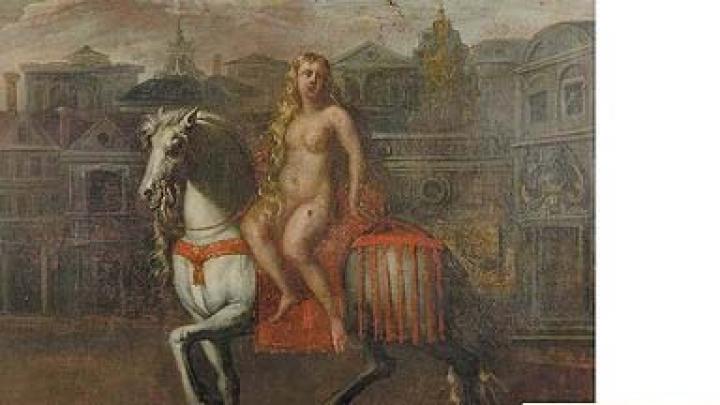Staggering beneath the yoke of oppressive taxes, the medieval residents of Coventry, England, pleaded in vain for relief. Ironically, deliverance would come from the wife of the very lord who scorned their pleas. Lady Godiva repeatedly urged her husband, Leofric, to lessen the people's tax burden, and time and again he refused. Yet she persisted, and one day in exasperation he told her he would lower taxes when she rode a horse, naked, through the streets of the town at midday. When she took him at his word and set out on her famous ride, the highborn Lady Godiva became an instant heroine to the common people of Coventry.
A fascinating piece of history. But as it happens, most medieval scholars agree the ride never took place. Professor of English and American literature and language Daniel Donoghue examines the origins and cultural significance of the myth in Lady Godiva: A Literary History of the Legend (Blackwell), and offers insights into how that myth has evolved over the centuries. "The story," he notes, "was based on the life of Godifu, a real woman who lived in Coventry in the latter part of the eleventh century and was married to one of the most powerful men in England."
Contemporary historians did not consider Godifu particularly noteworthy; what little was written about her at the time mentioned her merely as the wife of a famous man. But Donoghue points out that "two centuries after her death, chroniclers in the Benedictine abbey of St. Albans inserted a fully developed narrative into their Latin histories" and the legend of Lady Godiva was born. "Nobody knows quite why the legend was invented and attached to her name," he says, "but it does seem to function as a kind of myth of origin for the town of Coventry. At the end, Count Leofric seals the agreement about taxes with his own seal."
One of the myth's most interesting subplots involves the role of "Peeping Tom," who doesn't even appear in the story until the seventeenth century. According to legend, the people of Coventry, as a gesture of respect and appreciation for Lady Godiva's actions on their behalf, stayed indoors behind shuttered windows to preserve her modesty as she passed. Everyone, that is, except Tom, whose lustful curiosity compelled him to gaze at her and who was then, according to various versions of the legend, struck either blind or dead in punishment.
"Over time, Tom would become the scapegoat and bear the symbolic guilt for people's desire to look at this naked woman," says Donoghue. Tom would also become a compelling figure for artists and authors. In A Tour Thro' the Whole Island of Great Britain (1724-27), Daniel Defoe visited Coventry and spoke of "the poor fellow that peep'd out of the window to see her...looking out of a Garret in the High Street of the City." Tennyson's "Godiva" was a poem that, more than any other literary or historical work of its time, created a standard—and highly romanticized—version of the legend for the Victorian era. In the poem, Tom was blinded: "...but his eyes, before they had their will,/Were shrivell'd into darkness in his head,/And dropt before him. So the Powers, who wait/On noble deeds, cancell'd a sense misused;/And she, that knew not, pass'd...."
Given the sexual tension that the appearance of Tom creates between the observer and the observed, the prurient and the chaste, the punished and the rewarded, Donoghue writes, "Their pairing anticipates Sigmund Freud's clinical definitions of scopophilia and exhibitionism in terms of one another so well that he almost seems to have Peeping Tom in mind for the former and Lady Godiva for the latter. Only in recent years has Peeping Tom become extricated from the Godiva legend to the extent that it is possible to mention one without calling to mind the other."
The Godiva myth is filled with contradictions. The lady is obedient to her husband, yet boldly challenges his position on taxes. She rides naked through the streets of the city, yet remains chaste. She is a member of the ruling class who nonetheless sympathizes with the plight of ordinary people. Like other myths, this one offers ways to resolve—symbolically, at least—such conflicting social and sexual dynamics. Myths have also traditionally done what Donoghue describes as the "cultural work" of passing down history, tradition, and shared values. Now movies and television have essentially taken over that role from written and spoken tales. "One reason I decided to write this book was that the legend is dying out," says Donoghue. "Our children know about Godiva Chocolates, and they may have a visual image of a naked woman on a horse, but really know nothing about the story."
~Charles Coe
Daniel Donoghue e-mail address: dgd@wjh.harvard.edu







